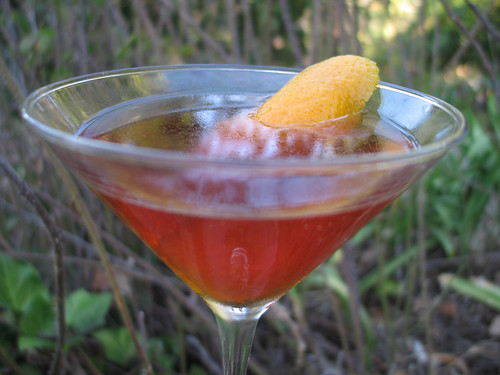This is one that I had noticed in The Savoy Cocktail Book, which compiled by The Savoy Hotel’s head barman Harry Craddock in 1930, but I never made it because it was was one that I feared. Why? Because at the time I feared Fernet Branca, one of the three (four, really) ingredients called for in this drink.
I have a history of fearing rather odd drink ingredients — there were days years ago when I feared both gin and vermouth, and now I’m gleefully swilling both of them nearly every day. I even grew to love Italian bitters, both as aperitivi and digestivi: Campari, Ramazzotti, Cora, Averna, Nonino … I grew to love them all. But not Fernet Branca. For the longest time it was the sole bottle in our bar that we kept around strictly for medicinal purposes.
Lest you chuckle at that old excuse for keeping alcohol around, it’s true. It’s a strong herbal liqueur, and as we’ve known for centuries herbs are used medicinally, and have effects on human physiology. When I first heard of Fernet Branca many years ago, the guy who turned me on to it called it “the medicine chest in my bar,” which for years was an apt description. If I ever had an upset stomach or nausea, particularly from overindulgence, all I needed was one shot of Fernet Branca and I would invariably feel better in less than five minutes. Hardcore Italian drinkers would take it as a shot, or sipped over ice; the person from whom I got the online tip recommended it the way his Italian grandmother took it, in a teacup with hot water and a tablespoon of honey.
The thing about Fernet Branca that took me so long to get over was not just its bitterness and herbal quality, which I enjoy very much. It’s got a pretty overwhelming astringent medicinal quality to it that tended to remind me too much of the Nasty Medicine I had to take all through my childhood. I knew it had good stuff in it, but why must it have a layer of Nasty Medicine on top?!
For quite a few years Wes and I had tried a few cocktails that called for Fernet Branca as an ingredient. We never could get past that medicinal quality, and never made them again, nor any other Fernet Branca cocktails. I kind of gave up.
Then, two Fridays ago, there was another in a long series of advanced post-graduate cocktailian colloquia — i.e., an evening of drinking at Dr. Cocktail’s house. After waking up our palates with the liquid equivalent of a 2×4 upside the head — sips of two wormwood-flavored bitter liqueurs (but not absinthes), Gorki List Pelinkovac from Serbia and the Swedish-style but Florida-made Malört, which Doc calls “eau de vie de dill pickle” and which is apparently hugely popular in biker bars, and both of which we rather liked — we were offered a Fernet Branca-containing cocktail. If it comes from the Doctor’s bar, I will try it, no matter what, so he told us about a drink invented by one Ada Coleman, who began work at the Savoy Hotel’s bar in London in 1903, a drink that became her most famous and longest-lived. Harry Craddock, who began work there in 1920 and who published The Savoy Cocktail Book in 1930, included it due to its continuing popularity.
The trick with this one, explained Doc, was using a really large orange twist not only to garnish the drink but from which you express as much orange oil as you can. The orange oil sprayed onto the surface of the drink, both for flavor and aroma, is what tames the Fernet Branca, reels it in, transforms it from Nasty Medicine to a marvelous subtle complexity.
I seem to recall Doc making this with a 2:1 proportion of gin to vermouth (I’ll have to double-check with him later), but we did it at the original proportion of 1:1. We did take Doc’s suggestion, since it worked so well the first time we tasted it, to up the Fernet Branca content from 2 dashes to 1/4 ounce, and to make sure we sprayed a lot of orange oil from the peel.

The Hanky Panky Cocktail
(Created by Ada Coleman, The American Bar, Savoy Hotel, London, early 20th Century)
1-1/2 ounces dry gin.
1-1/2 ounces sweet vermouth.
1/4 ounce Fernet Branca.
Large slice of orange peel (1-1/2″ x 4″ approx.)
Stir with cracked ice for no less than 30 seconds, and strain into a chilled cocktail glass. Twist the peel over the drink to spray out as much orange oil as you can onto the surface of the drink; garnish with the peel.
The Hanky Panky Cocktail
(Dr. Cocktail variation from CocktailDB.com)
1-3/4 ounces gin.
3/4 ounce sweet vermouth.
1/4 ounce Fernet Branca.
It was very cool indeed to sip this drink while toasting its creator, who conceived of it nearly a century ago. I also have Ada (and Doc) to thank for finally breaking my fear of Fernet Branca, as we’ll make the Hanky Panky often.
[2010 UPDATE] Nowadays I love Fernet Branca so much I keep a flask of it in my bag at most, if not all, times. How about a Fernet Old Fashioned?






